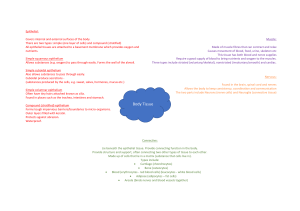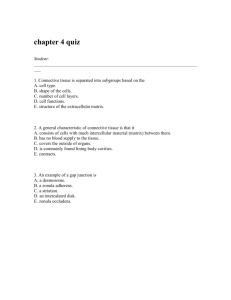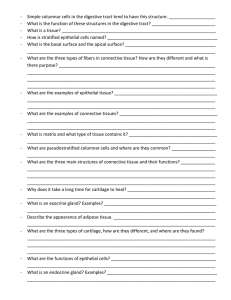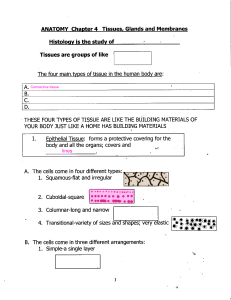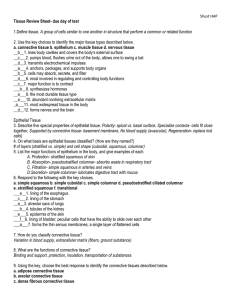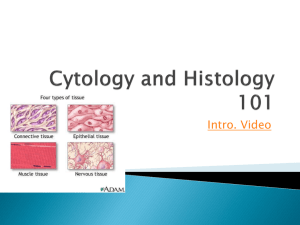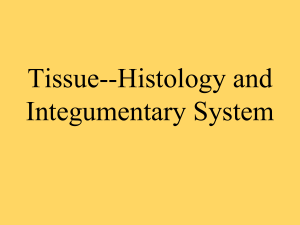Seng Lily Moua Hour 1 Anatomy and Physiology Chapter 4 Review
advertisement
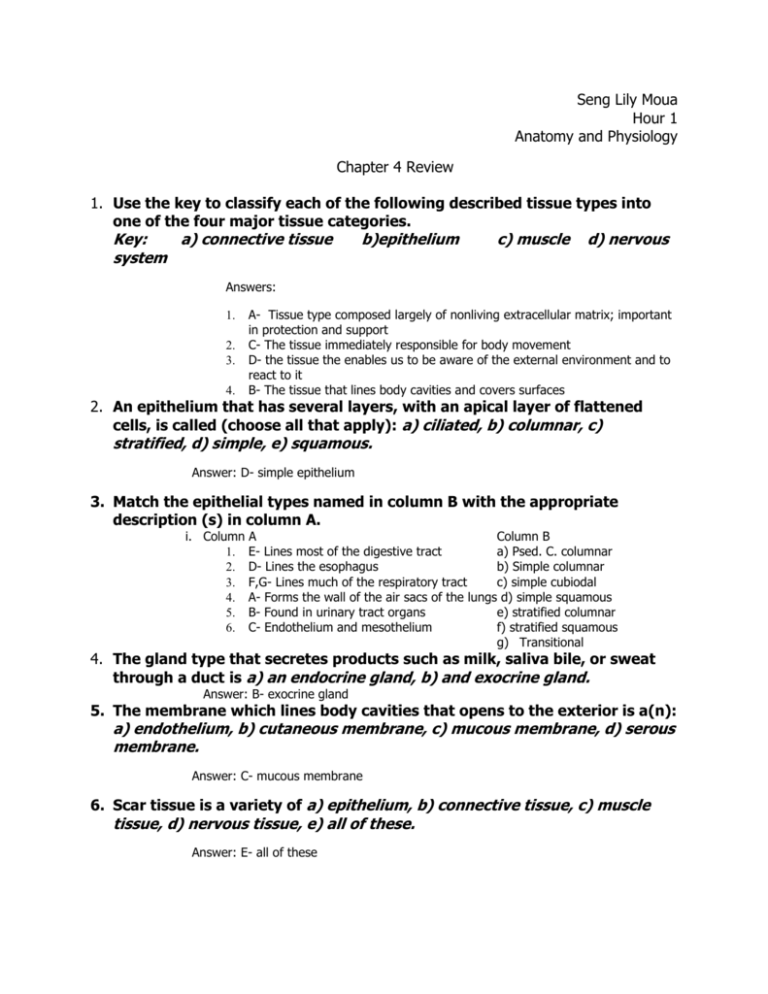
Seng Lily Moua Hour 1 Anatomy and Physiology Chapter 4 Review 1. Use the key to classify each of the following described tissue types into one of the four major tissue categories. Key: a) connective tissue system b)epithelium c) muscle d) nervous Answers: 1. 2. 3. 4. A- Tissue type composed largely of nonliving extracellular matrix; important in protection and support C- The tissue immediately responsible for body movement D- the tissue the enables us to be aware of the external environment and to react to it B- The tissue that lines body cavities and covers surfaces 2. An epithelium that has several layers, with an apical layer of flattened cells, is called (choose all that apply): a) ciliated, b) columnar, c) stratified, d) simple, e) squamous. Answer: D- simple epithelium 3. Match the epithelial types named in column B with the appropriate description (s) in column A. i. Column A Column B 1. E- Lines most of the digestive tract a) Psed. C. columnar 2. D- Lines the esophagus b) Simple columnar 3. F,G- Lines much of the respiratory tract c) simple cubiodal 4. A- Forms the wall of the air sacs of the lungs d) simple squamous 5. B- Found in urinary tract organs e) stratified columnar 6. C- Endothelium and mesothelium f) stratified squamous g) Transitional 4. The gland type that secretes products such as milk, saliva bile, or sweat through a duct is a) an endocrine gland, b) and exocrine gland. Answer: B- exocrine gland 5. The membrane which lines body cavities that opens to the exterior is a(n): a) endothelium, b) cutaneous membrane, c) mucous membrane, d) serous membrane. Answer: C- mucous membrane 6. Scar tissue is a variety of a) epithelium, b) connective tissue, c) muscle tissue, d) nervous tissue, e) all of these. Answer: E- all of these 7. Define tissue: A group of similar cells and their intercellular substance specialized to perform a specific function; primary tissue types of the body are epithelial, connective, muscle, and nervous system. 8. Name four important functions of epithelial tissue and provide an example: 1) protection, 2) absorption, 3) filtration, 4) excretion. An example: The epithelium of the skin protects underlying tissues from mechanical and chemical injury and bacterial invasion and contains nerve endings that respond to various stimuli action at the skin surface. 9. Describe the criteria used to classify covering and lining epithelia: Covering and lining epithelium forms the outer layer of the skin, dips into and lines the open cavities of the cardiovascular, digestive, and respiratory systems, and covers the walls and organs of the closed ventral body cavity. 10. Explain the functional classification of multicellular exocrine glands and supply and example for each class: 11. Provide examples from the body that illustrate four of the major functions of connective tissue: Heart, Aorta, Costal cartilage, shoulder joint, ligament, and tendon. 12. Name the primary cell type in connective tissue proper; in cartilage; in bone: Fibroblast. 13. Name the two major components of matrix and, if applicable, subclasses of each component: The two major components of the matrix are ground substances and fibers. Fibers can be broken into the classes; collagen, elastic and reticular fibers. 14. Matrix is extracellular. How does the matrix get to its characteristic position? Most body cells are in contact with a jelly like substance composed of proteins and polysaccharides. These molecules are secreted by the cells and self assemble into an organized mesh in the extracellular space, where they serve as a universal "cell glue" that helps hold the body cells together. 15. Name the specific connective tissue type found in the following body locations: a) forming the soft packing around organs, b) supporting the ear pinna, c) forming “stretchy” ligaments, d) first connective tissue in the embryo, e) forming the intervertebral discs, f) covering the ends of bones at joint surfaces, g) main component of subcutaneous tissue: 16. What is the function of macrophages: They are known as “big eaters”. Dispose of dead tissue cells, and they are central actors in the immune system. 17. Differentiate clearly between the roles of neurons and the supporting cells of nervous tissue: Cells are microscopic organisms throughout your body. They are the smallest things that are capable of performing life functions. Tissues are cells that clump together and form organs. 18. Compare and contrast skeletal cardiac, and smooth muscle tissue relative to structure, body location, and specific function: 19. Describe the process of tissue repair, making sure you indicate factors that influence this process: 20. Indicate which primary layer: Epithelial tissue tissue classes derive from each embryonic germ 21. In what ways are adipose tissue and bone similar? How are they different? ONE CRITICAL THINKING #3. This can cause serious problems because they can be displaced or disconnected to the other bone. Or the blood running through the joints can disperse and cause a bleeding in your body.

